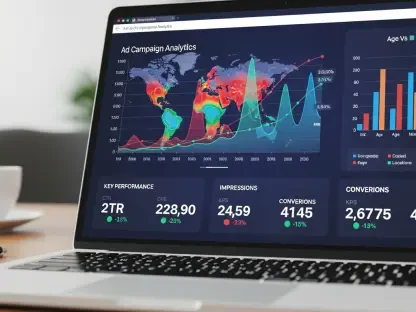In a landscape where digital screens capture consumer attention like never before, global advertising spend has surged to an astonishing $1.17 trillion this year, marking a pivotal moment for the industry. This remarkable growth, driven by a robust 7.4% increase over last year, underscores the transformative power of digital platforms in reshaping how brands engage with audiences. What forces are propelling this unprecedented boom, and how can marketers harness these trends to stay ahead? This market analysis delves into the key drivers behind the surge, examines critical data and patterns, and explores projections that could define the future of advertising in a digital-first world.
Digital Platforms Lead the Charge in Ad Spend Growth
The advertising sector is witnessing a historic shift, with digital channels commanding the lion’s share of new investments. Data reveals that nine out of every ten incremental dollars in market growth are flowing into digital spaces, a clear signal of the decline of traditional media like newspapers and broadcast television. Social media, in particular, stands out as a dominant force, capturing 40.6% of new ad dollars. Platforms such as Instagram, with an 18.8% growth rate, and TikTok, skyrocketing at 56.8%, have become essential for brands aiming to connect with consumers through visually engaging content.
Retailers, now the largest spending category on these platforms, are leveraging social media to drive direct engagement, while sectors like technology and consumer electronics also contribute significantly to this uptick. However, the rapid growth comes with caveats, as regulatory uncertainties—especially surrounding TikTok in certain markets—pose potential risks. Despite these challenges, the momentum of social media as a marketing powerhouse remains undeniable, pushing brands to rethink their allocation strategies in favor of digital outreach.
Beyond social media, non-retail search and retail media hold substantial shares at 22.2% and 21.5% of new ad dollars, respectively. Retail media alone has expanded by 13.7% to reach $175 billion, representing 14.9% of the total global market. Amazon leads this segment with a commanding 35.4% share, though forecasts indicate a slowdown to an average growth rate of 12.6% in the coming years due to market saturation. This evolving dynamic highlights the need for brands to balance investment in established digital channels with exploration of emerging opportunities.
Economic Catalysts and Short-Term Boosts in Spending
A notable factor fueling the current ad spend surge is a phenomenon dubbed the “pre-tariff windfall.” In the second quarter of this year, brands in tariff-sensitive industries preemptively stockpiled inventory and intensified promotional campaigns to offset anticipated price hikes from potential trade policies. This strategic move injected an additional $4.9 billion into the market, with social media ad investments witnessing a striking 20.2% year-over-year increase, far surpassing earlier expectations.
Industries such as technology and consumer electronics led this rush, channeling significant budgets into platforms that offer immediate consumer reach. While this windfall presents a short-term opportunity, it also raises questions about sustainability. As trade tensions persist, the risk of overextending budgets looms large, prompting marketers to carefully assess whether this spike is a fleeting boost or a precursor to more stable growth. The interplay between economic policies and advertising decisions underscores the complexity of navigating today’s market.
This temporary surge also amplifies the importance of agility in budget planning. Brands that capitalized on the pre-tariff window gained a competitive edge, but those unprepared for potential downturns may face challenges. The lesson here lies in the ability to anticipate external pressures and adapt swiftly, ensuring that short-term gains do not compromise long-term stability in an unpredictable economic climate.
Powerhouses and Market Concentration Shape the Landscape
The concentration of ad spend among a digital triopoly—comprising Alphabet, Amazon, and Meta—reveals a market increasingly dominated by a handful of tech giants. Together, these companies control 55.8% of global ad spend, excluding certain major markets, highlighting their unparalleled influence over advertising trends. Their data-driven capabilities and expansive reach make them indispensable partners for brands seeking precision in targeting and scalability in campaigns.
While this dominance ensures efficiency for many advertisers, it also sidelines smaller platforms struggling to carve out relevance in a crowded space. The disparity in market share points to a competitive imbalance, where innovation from emerging players often gets overshadowed by the resources of these giants. Marketers must weigh the benefits of partnering with established leaders against the potential for differentiation through niche or localized platforms.
This concentration also sparks concerns about market diversity and the risk of over-reliance on a few key players. As the triopoly continues to shape industry standards, there is a pressing need for regulatory frameworks to foster competition. For now, brands are tasked with navigating this landscape by diversifying their digital investments to mitigate dependency while still leveraging the strengths of these dominant forces.
Projections and Emerging Trends for the Future
Looking ahead, the global ad market is on track to nearly double in nominal value by 2027 compared to figures from a few years ago, potentially reaching $1.36 trillion. This projection reflects the enduring strength of digital platforms, bolstered by advancements in AI and data analytics that promise even more targeted and personalized campaigns. The integration of such technologies is expected to redefine engagement, offering brands deeper insights into consumer behavior.
However, the path forward is not without obstacles. Regulatory challenges, including potential restrictions on key platforms, could alter market dynamics significantly. Economic factors like ongoing trade disputes may also force recalibrations in budget allocations, particularly for industries vulnerable to policy shifts. Despite these uncertainties, the trajectory suggests that digital channels will maintain their stronghold, with social media and retail media continuing to attract substantial investments.
Emerging platforms and localized strategies are poised to gain traction as brands seek to stand out in a saturated digital environment. Smaller players offering unique value propositions could provide avenues for differentiation, especially for marketers targeting specific demographics or regions. Balancing innovation with adaptability to external pressures will likely be the cornerstone of success in the evolving advertising arena over the next few years.
Reflecting on the Market Evolution and Strategic Pathways
Looking back, the dramatic rise in global ad spend reflected a transformative chapter for the industry, as digital platforms solidified their dominance and traditional media faded into the background. The pre-tariff windfall underscored how economic catalysts could spur short-term surges, while the overwhelming control of a digital triopoly highlighted both opportunities and challenges in market competition. This period of rapid growth, driven by social media and retail media, painted a picture of resilience amid economic volatility.
For marketers, the next steps involve prioritizing digital channels to capture consumer attention, while diversifying investments to hedge against regulatory or economic disruptions. Monitoring macro trends, such as trade policies, becomes essential for seizing short-term opportunities without sacrificing long-term goals. Smaller brands find potential in partnering with niche platforms to carve out unique spaces, blending precision with flexibility to thrive in a dynamic landscape. The journey ahead demands a strategic focus on innovation, ensuring that the lessons of this boom inform sustainable growth in an ever-shifting market.









